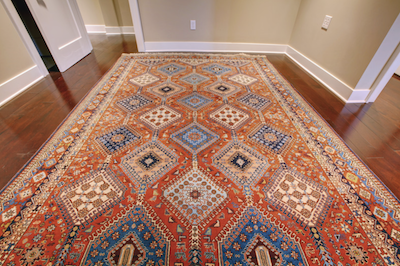Padding
A quality pad used under your rug helps protect it from damage, wear and slippage. Every rug needs one. For a flat weave, use rubber waffle pad and for a thick hand knotted or tufted, use rubber backed synthetic felt. Always replace the pad if the rug has had pet contamination.
Vacuuming
Like most carpeting, rugs should be vacuumed at least weekly to remove dry soil, lint, and hair. If in an entryway, vacuum more often. Be cautious not to vacuum the fringe with your brush bar! Use the end of a vacuum hose from a canister vacuum. Every few months turn the rug face down on a clean, dry smooth surface and vacuum to vibrate out the embedded dry soil.
Rotation – To ensure even wear, your rug should be rotated. Depending on the traffic, the rotation may vary from every six months to once a year.
Spot and Spill Procedures
- Make sure that you safely and immediately clean up spots and spills before they set.
- Scoop up or scrape the solids off of the carpet or rug
- Soak or blot up the excess liquid by blotting with a clean absorbent material. Do not brush or scrub the stain.
- Always work from the edge of the spot inwards
- Then spot clean with a WoolSafe-approved spotter www.woolsafeusa.org/consumerproducts or mild liquid laundry detergent solution mixed 1/2 teaspoon with 1-quart water. Apply small quantities at a time, applied to a cloth, NOT directly to the spot; work into the spot with a small brush or sponge
- Do not over wet. Blot dry until most of the moisture has been absorbed and color is no longer visible on the towel.
- Rinse area thoroughly with a mixture of 6-parts water to one part white distilled vinegar. Avoid wetting the rug’s backing.
- Dry completely. A fan or cool hair dryer can be used to speed up the drying process.
- Some stains or animal contamination you may find impossible to remove completely in which case the assistance of a professional may be required.
- For stains that do not come out using these methods, consult registered
Garec’s Cleaning Systems.

